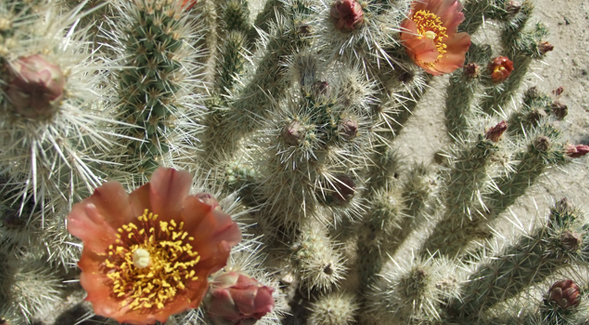A Blossoming Collaboration
SDSU will digitize its plant collection for a statewide effort aimed at understanding effects of climate change on flowering time.

The wolf’s cholla cactus (Cylindropuntia wolfii) is an intimidating tangle of thorny green limbs inhabiting the Sonoran Desert of Southern California and Baja California. Yet once a year, its prickly stems erupt with bright red and yellow flowers, beacons for the desert’s wild bees and other pollinators. Usually, the cholla blooms in April, but when San Diego State University evolutionary plant ecologist Lluvia Flores-Rentería visited the Sonoran Desert during that time earlier this year, the flowers weren’t there.
What happened to the wolf’s cholla this year might be part of a larger, worldwide pattern of shifting flowering times for many plants in response to a warming climate. Even small shifts in flowering time can have major consequences if plants get out of sync with pollinators, pests or agricultural schedules. Quantifying where and how quickly these shifts are occurring, and to which plants, is a tricky task, however.
That’s where formal collections of preserved plants, known as herbaria, come in. For centuries, botanists have recorded information about millions of plant specimens, then dried, pressed and filed them away in closets and drawers. These records indicate exactly where and when they were collected, as well as whether they were flowering or fruiting at the time. The data are spread between numerous disparate collections, though, making it virtually impossible for scientists to analyze the sum of their contained knowledge.
In California, a new program could change that. In response to a request by botanist Jenn Yost at Cal Poly San Luis Obispo, the National Science Foundation last month awarded $1.5 million to 19 universities, botanical gardens and natural history museums across the state. San Diego State University received $25,000 as part of this effort, which will allow the university to purchase a specialized camera and mount to make high-resolution images of the specimens in its collection.
A second tranche of the grant money will support the hiring of several students to input these photos and their metadata—including the date and place the specimens were collected and whether they were in flower—into a statewide online database.
“The idea is to digitize all these historical and contemporary specimens from all the herbaria across California, including georeferenced data, timing of flowering, budding, fruiting, et cetera,” said Flores-Rentería.
The digitization project will take about a year to complete and will involve citizen scientists to double-check the inputs, ensuring the species labels match the photos. Enterprising researchers can then sort through this digitized information to look for shifts in flowering times that match up with temperature changes and other climate patterns.
“With that type of digitized and organized data, we think we’ll be able to make some inferences about climate change,” said professor emeritus Michael Simpson, curator of the SDSU Herbarium. “This has never been done in California.”
Housed in the Life Sciences Building, the SDSU Herbarium contains about 22,000 dried and pressed specimens, some of which date back to the 1860s. It includes one of the largest and most complete collections of a widespread, diverse plant family known as Boraginaceae, or popcorn flowers, after their clusters of puffy white flowers.
The San Diego Natural History Museum’s herbarium will join SDSU in representing the San Diego region in the statewide digitization effort. Their collections represent an especially critical piece of the puzzle for scientists looking to understand climate change’s effects on flowering time, Simpson explained.
“California is the most biodiverse state,” he said, “and San Diego County is home to more species of plants than any other county in the country. We have plants that grow along the coast, in the desert, in the mountains, just about every type of biome, so San Diego has a wide and diverse sample.”



